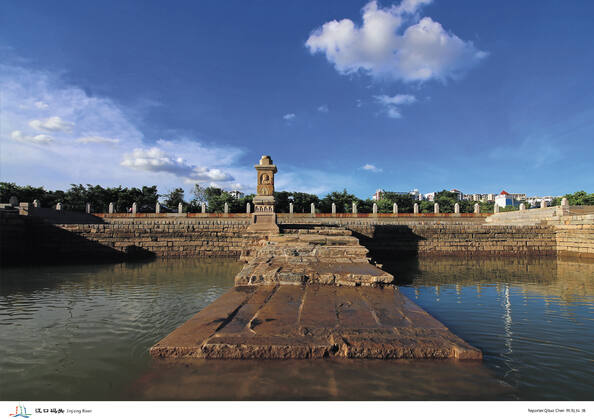Quanzhou: Emporium of the World in Song-Yuan China
Quanzhou: Emporium of the World in Song-Yuan China
The serial site of Quanzhou illustrates the city’s vibrancy as a maritime emporium during the Song and Yuan periods (10th - 14th centuries AD) and its interconnection with the Chinese hinterland. Quanzhou thrived during a highly significant period for maritime trade in Asia. The site encompasses religious buildings, including the 11th century AD Qingjing Mosque, one of the earliest Islamic edifices in China, Islamic tombs, and a wide range of archaeological remains: administrative buildings, stone docks that were important for commerce and defence, sites of ceramic and iron production, elements of the city’s transportation network, ancient bridges, pagodas, and inscriptions. Known as Zayton in Arabic and western texts of the 10th to 14th centuries AD.La description est disponible sous licence CC-BY-SA IGO 3.0
Quanzhou : emporium mondial de la Chine des Song et des Yuan
Le site en série de Quanzhou illustre le dynamisme de la ville en tant qu’emporium maritime pendant les périodes Song et Yuan (Xe-XIVe siècles de notre ère) et ses interconnexions avec l’arrière-pays chinois. Quanzhou a prospéré pendant une période très importante pour le commerce maritime en Asie. Le site comprend des édifices religieux, notamment la mosquée Qingjing, du XIe siècle, l’un des premiers édifices islamiques de Chine, des tombes islamiques et un large éventail de vestiges archéologiques : bâtiments administratifs, quais en pierre qui étaient importants pour le commerce et la défense, sites de production de céramique et de fer, éléments du réseau de transport de la ville, ponts anciens, pagodes et inscriptions. La ville était connue sous le nom de Zayton dans des textes arabes et occidentaux du Xe au XIVe siècle de notre ère.
La description est disponible sous licence CC-BY-SA IGO 3.0
تشوانتشو: مركز العالم التجاري في سونغ تشوان بالصين
يجسّد الموقع المتسلسل لمدينة تشانتشو الحيوية التي كانت تنعم بها المدينة كمركزٍ تجاريّ بحريّ خلال فترتَي حكم سُلالَتي سونغ ويوان بين القرنين العاشر والرابع عشر بعد الميلاد، فضلاً عن ضروب التواصل والترابط بين المدينة وبين الأراضي الصينيّة الداخلية النائية. وازدهرت مدينة تشانتشو خلال مرحلة بالغة الأهميّة على صعيد التجارة البحريّة في آسيا. ويحتضن الموقع جملةً من الصروح الدينيّة على غرار مسجد تشينغ جينغ (مسجد الأصحاب) الذي يعود تاريخه إلى القرن الحادي عشر وهو واحد من أقدم الصروح الإسلامية في الصين، ناهيك عن المقابر الإسلامية، وطيف واسع من البقايا الأثرية مثل المباني الإدارية، وأرصفة الموانئ الحجريّة الهامّة لأغراض التجارة والدفاع، ومواقع إنتاج السيراميك والحديد، وعناصر من شبكة النقل في المدينة، والجسور القديمة، والمعابد، والنقوش. كانت المدينة تُعرف باسم "زيتون" في النصوص العربية والغربية التي تعود إلى الفترة الممتدة من القرن العاشر إلى القرن الرابع عشر الميلادي.
source: UNESCO/CPE
La description est disponible sous licence CC-BY-SA IGO 3.0
泉州:宋元中国的世界海洋商贸中心
该遗址群体现了泉州在宋元时期(公元10-14世纪)作为世界海洋商贸中心的活力,及其与中国腹地的紧密联系。泉州在亚洲海运贸易的这个重要时期蓬勃发展。遗产地包括多座宗教建筑,如始建于公元11世纪的清净寺(中国最早的伊斯兰建筑之一)、伊斯兰教圣墓,以及大量考古遗迹,如行政建筑、具有重要商贸和防御意义的石码头、制瓷和冶铁生产遗址、城市交通网道的构成元素、古桥、宝塔和碑文。在公元10-14世纪的阿拉伯和西方文献中,泉州被称为刺桐。该遗产地还包括一座保留了部分原貌的元代寺庙,以及世界上仅存的摩尼石像。摩尼是摩尼教(又称琐罗亚斯德教)的创始人,该教约于公元6-7世纪传入中国。
source: UNESCO/CPE
La description est disponible sous licence CC-BY-SA IGO 3.0
Цюаньчжоу: мировой центр торговли в Китае эпохи династий Сун-Юань
Серийный объект Цюаньчжоу иллюстрирует динамику города как морского центра торговли в периоды Сун и Юань (X-XIV вв. н. э.) и его взаимосвязь с внутренними районами Китая. Цюаньчжоу процветал в весьма значительный период для морской торговли в Азии. На территории объекта расположены религиозные здания, в том числе мечеть Цинцзин XI века, одна из самых ранних исламских построек в Китае, исламские гробницы и широкий спектр археологических памятников: административные здания, каменные доки, имевшие важное значение для торговли и обороны, места производства керамики и железа, элементы транспортной сети города, древние мосты, пагоды и надписи. Цюаньчжоу был ранее известен как Зайтон в арабских и западных текстах Х-XIV веков.
source: UNESCO/CPE
La description est disponible sous licence CC-BY-SA IGO 3.0
Quanzhou, emporio mundial de la China de los Song y los Yuan
Los componentes de este sitio ilustran la vitalidad de la ciudad de Quanzhou como emporio marítimo en la época de las dinastías Song y Yuan (siglos X a XIV de nuestra era), y también como punto de conexión con la China continental. Conocida con el nombre de Zayton en los textos árabes y europeos de los siglos X a XIV, Quanzhou posee antiguos edificios religiosos entre los que figura la mezquita de Qingjing (siglo XI), una de las primeras construcciones de culto musulmán de toda China. También cuenta con tumbas islámicas y con un vasto conjunto de vestigios arqueológicos de todo tipo: edificios administrativos, muelles y embarcaderos de piedra importantes para el comercio y la defensa, elementos de la red local de transportes y talleres de cerámica y metalurgia, así como inscripciones, pagodas y puentes antiguos.
source: UNESCO/CPE
La description est disponible sous licence CC-BY-SA IGO 3.0
